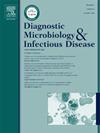Isolation of Lancefieldella parvula in Secondary Infection from Human Bite: A Rare Occurrence
IF 2.1
4区 医学
Q3 INFECTIOUS DISEASES
Diagnostic microbiology and infectious disease
Pub Date : 2025-04-11
DOI:10.1016/j.diagmicrobio.2025.116842
引用次数: 0
Abstract
Background
Human bite infections most commonly manifest as skin and soft tissue infections with lower infection rates than animal bites. Lancefieldella parvula is an anaerobe Gram-positive coccus found in human oral mucosa.
Case Presentation
We present the case of a 28-year-old healthy woman who suffered a deep skin and soft tissue infection in the left hand after a human bite. She presented with signs and symptoms of infection unresponsive to antibiotics, requiring admission for surgical debridement. Microbiological cultures were taken from the wound and empirical treatment was initiated with ciprofloxacin and clindamycin. Cultures were positive for Lancefieldella parvula by Matrix Assisted Laser Desorption Ionization-Time of Flight (MALDI-TOF) which was genetically confirmed by 16S sequencing. The patient required two surgical debridements and digit amputation; and was treated with levofloxacin for five days recovered, achieving complete resolution of symptoms.
Conclusions
Timely surgical management and targeted antimicrobial therapy in severe human bite infections is crucial. The identification of Lancefieldella parvula using advanced tools like MALDI-TOF emphasizes the need to consider uncommon microorganisms in the differential diagnosis.
人咬伤继发感染中分离出细小兰斯菲尔德菌:罕见的病例
人类咬伤感染最常见的表现为皮肤和软组织感染,感染率低于动物咬伤感染。小舌兰斯菲尔德菌是一种存在于人口腔黏膜的革兰氏阳性厌氧菌。病例介绍我们提出的情况下,28岁的健康妇女谁遭受了深皮肤和软组织感染后,在人类咬伤左手。她出现感染的体征和症状,对抗生素无反应,需要住院进行手术清创。从创面进行微生物培养,并用环丙沙星和克林霉素进行经验性治疗。基质辅助激光解吸电离飞行时间(MALDI-TOF)培养结果为小vula Lancefieldella parvula阳性,经16S测序证实。患者需要两次手术清创和手指截肢;经左氧氟沙星治疗5天,症状完全缓解。结论及时手术治疗和靶向抗菌药物治疗是治疗重症人咬伤感染的关键。利用MALDI-TOF等先进工具鉴定小苗兰氏菌,强调了在鉴别诊断中考虑罕见微生物的必要性。
本文章由计算机程序翻译,如有差异,请以英文原文为准。
求助全文
约1分钟内获得全文
求助全文
来源期刊
CiteScore
5.30
自引率
3.40%
发文量
149
审稿时长
56 days
期刊介绍:
Diagnostic Microbiology and Infectious Disease keeps you informed of the latest developments in clinical microbiology and the diagnosis and treatment of infectious diseases. Packed with rigorously peer-reviewed articles and studies in bacteriology, immunology, immunoserology, infectious diseases, mycology, parasitology, and virology, the journal examines new procedures, unusual cases, controversial issues, and important new literature. Diagnostic Microbiology and Infectious Disease distinguished independent editorial board, consisting of experts from many medical specialties, ensures you extensive and authoritative coverage.

 求助内容:
求助内容: 应助结果提醒方式:
应助结果提醒方式:


